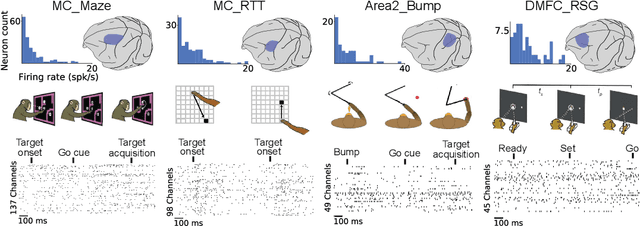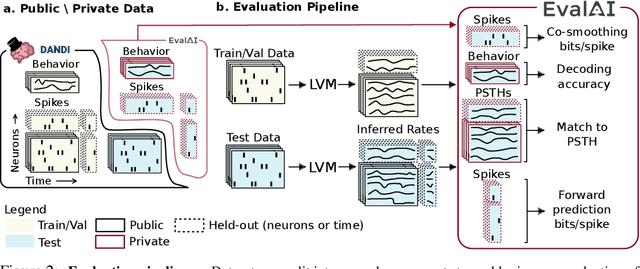Krishna V. Shenoy
Plug-and-Play Stability for Intracortical Brain-Computer Interfaces: A One-Year Demonstration of Seamless Brain-to-Text Communication
Nov 06, 2023Abstract:Intracortical brain-computer interfaces (iBCIs) have shown promise for restoring rapid communication to people with neurological disorders such as amyotrophic lateral sclerosis (ALS). However, to maintain high performance over time, iBCIs typically need frequent recalibration to combat changes in the neural recordings that accrue over days. This requires iBCI users to stop using the iBCI and engage in supervised data collection, making the iBCI system hard to use. In this paper, we propose a method that enables self-recalibration of communication iBCIs without interrupting the user. Our method leverages large language models (LMs) to automatically correct errors in iBCI outputs. The self-recalibration process uses these corrected outputs ("pseudo-labels") to continually update the iBCI decoder online. Over a period of more than one year (403 days), we evaluated our Continual Online Recalibration with Pseudo-labels (CORP) framework with one clinical trial participant. CORP achieved a stable decoding accuracy of 93.84% in an online handwriting iBCI task, significantly outperforming other baseline methods. Notably, this is the longest-running iBCI stability demonstration involving a human participant. Our results provide the first evidence for long-term stabilization of a plug-and-play, high-performance communication iBCI, addressing a major barrier for the clinical translation of iBCIs.
Neural Latents Benchmark '21: Evaluating latent variable models of neural population activity
Sep 10, 2021



Abstract:Advances in neural recording present increasing opportunities to study neural activity in unprecedented detail. Latent variable models (LVMs) are promising tools for analyzing this rich activity across diverse neural systems and behaviors, as LVMs do not depend on known relationships between the activity and external experimental variables. However, progress in latent variable modeling is currently impeded by a lack of standardization, resulting in methods being developed and compared in an ad hoc manner. To coordinate these modeling efforts, we introduce a benchmark suite for latent variable modeling of neural population activity. We curate four datasets of neural spiking activity from cognitive, sensory, and motor areas to promote models that apply to the wide variety of activity seen across these areas. We identify unsupervised evaluation as a common framework for evaluating models across datasets, and apply several baselines that demonstrate benchmark diversity. We release this benchmark through EvalAI. http://neurallatents.github.io
Making brain-machine interfaces robust to future neural variability
Oct 19, 2016



Abstract:A major hurdle to clinical translation of brain-machine interfaces (BMIs) is that current decoders, which are trained from a small quantity of recent data, become ineffective when neural recording conditions subsequently change. We tested whether a decoder could be made more robust to future neural variability by training it to handle a variety of recording conditions sampled from months of previously collected data as well as synthetic training data perturbations. We developed a new multiplicative recurrent neural network BMI decoder that successfully learned a large variety of neural-to- kinematic mappings and became more robust with larger training datasets. When tested with a non-human primate preclinical BMI model, this decoder was robust under conditions that disabled a state-of-the-art Kalman filter based decoder. These results validate a new BMI strategy in which accumulated data history is effectively harnessed, and may facilitate reliable daily BMI use by reducing decoder retraining downtime.
* D.S., S.D.S., and J.C.K. contributed equally to this work
 Add to Chrome
Add to Chrome Add to Firefox
Add to Firefox Add to Edge
Add to Edge